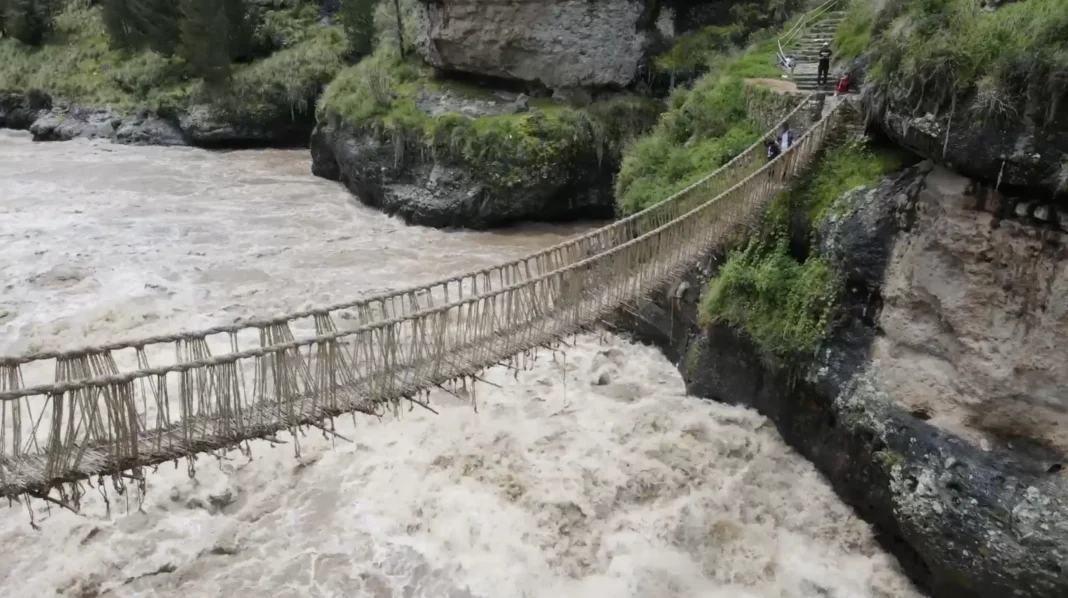Each year, as the month of June approaches, the residents of four Indigenous communities in Peru embark on a journey that has been passed down for centuries. It is a journey to rebuild the last remaining Incan rope bridge, an incredible feat that has become a symbol of resilience and strength for these communities. This is episode 48 of Stories of Resistance, a powerful reminder of the indomitable spirit of the Peruvian people.
The history of the Incan rope bridge dates back to the 15th century when the Incan empire was at its peak. These bridges were essential for connecting the different regions of the empire and were built using traditional weaving techniques. The bridge was made of fibers from the Q’oya plant, a type of grass that is native to the Andean region. The bridge was not only a means of transportation but also a symbol of the Incan culture and their advanced engineering skills.
However, with the arrival of the Spanish conquistadors in the 16th century, the Incan empire was destroyed, and much of its culture and traditions were lost. The once-great Incan rope bridges were no exception and were left to deteriorate, with only a few remaining in remote areas of Peru.
But the legacy of these bridges and their importance to the Indigenous communities did not fade away. It was kept alive through oral traditions and stories passed down from generation to generation. And in the 1970s, a group of community members from the Quehue, Huinchiri, Choccayhua, and Ccolana communities came together to revive this ancient tradition.
Every year, during the first week of June, these communities come together to rebuild the Q’eswachaka rope bridge, which spans over 120 feet across the Apurimac River. The process of rebuilding the bridge is a remarkable display of teamwork, determination, and cultural pride. The communities gather the Q’oya plant fibers and use them to weave long ropes, which are then braided together to form the bridge’s main cables. The bridge is then completed with wooden planks and handrails made from the same plant fibers.
The rebuilding of the Q’eswachaka bridge is not just a physical feat but also a spiritual one. The communities perform rituals and ceremonies to bless the bridge, thanking the Apurimac River and the mountains for providing the materials and asking for their protection. This ritual also serves as a reminder of the Indigenous beliefs and connection to nature, which have been passed down for generations.
The process of rebuilding the bridge takes about three days, and once completed, it is opened to the public with a grand celebration. Visitors from all over the world come to witness this incredible event and learn about the history and cultural significance of the Incan rope bridge. The bridge stands as a testament to the strength and resilience of the Indigenous communities, who have kept this tradition alive for centuries.
The Q’eswachaka bridge has not only become a symbol of cultural identity but also an important economic driver for these communities. The bridge attracts tourists, and the communities sell handmade crafts and offer cultural experiences, providing a source of income for many families.
This tradition of rebuilding the Q’eswachaka bridge has not been without its challenges. The harsh weather conditions, such as heavy rains and strong winds, often damage the bridge, requiring it to be rebuilt every year. But the communities are determined to keep this tradition alive, and with each passing year, the bridge becomes a little stronger, just like the bonds between the communities.
The rebuilding of the Q’eswachaka bridge is a testament to the resilience and perseverance of the Indigenous communities in Peru. It is a reminder of their rich cultural heritage and their unwavering spirit to preserve it. This tradition has become an inspiration for many, and it is a powerful symbol of resistance against the forces that have tried to erase the Indigenous culture.
As we celebrate episode 48 of Stories of Resistance, let us take a moment to appreciate the strength and determination of these communities and the importance of preserving our cultural heritage. The Q’eswachaka bridge stands tall, not just as a physical structure, but as a symbol of the unbreakable spirit of the Peruvian people. Let us continue to honor and support the Indigenous communities in their efforts to keep this tradition alive for generations to come.


